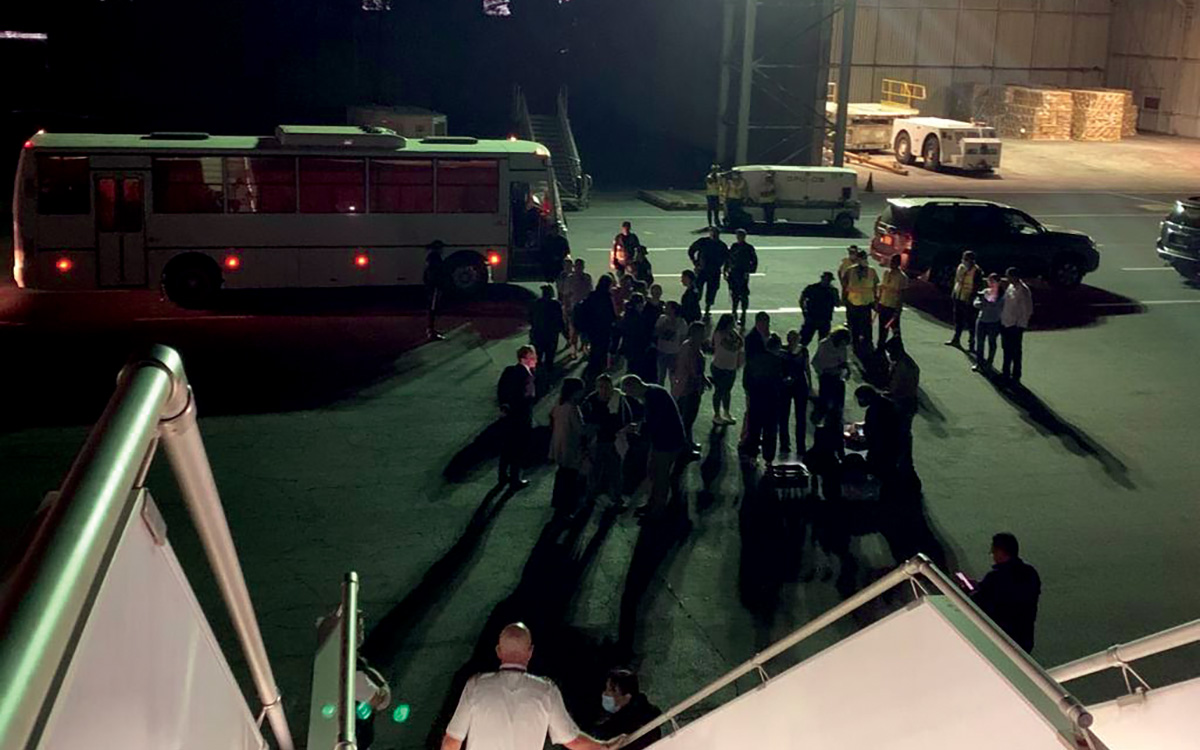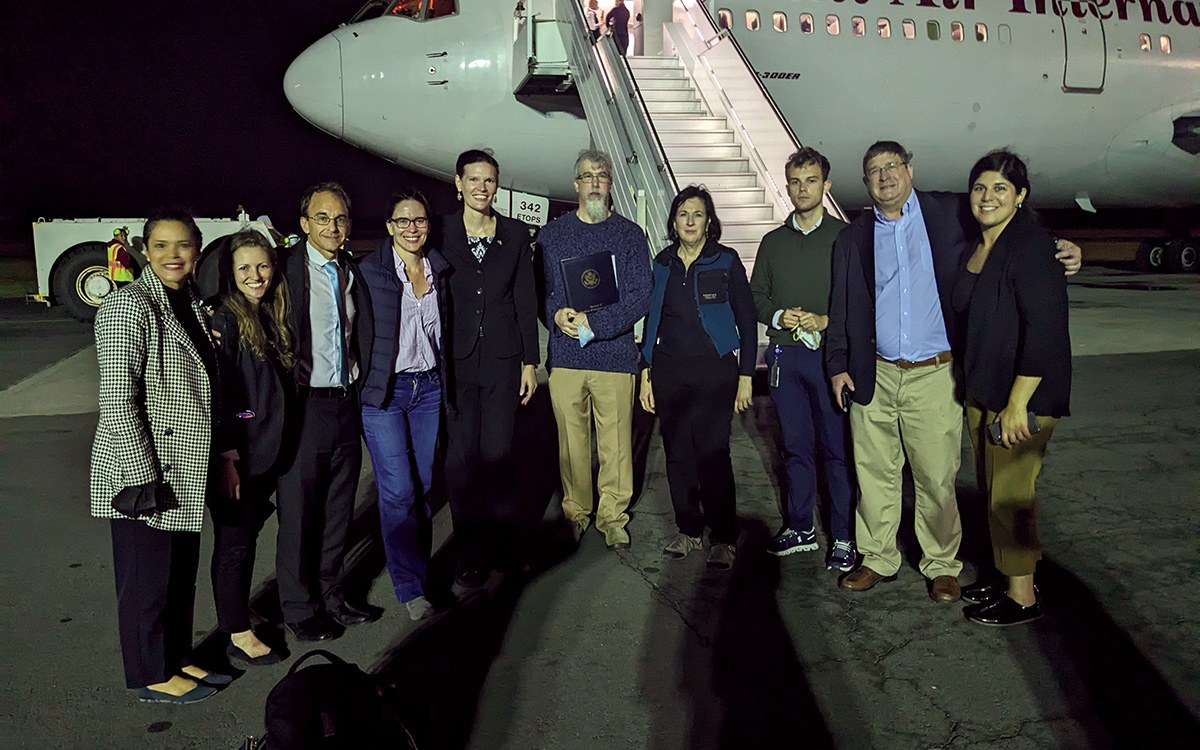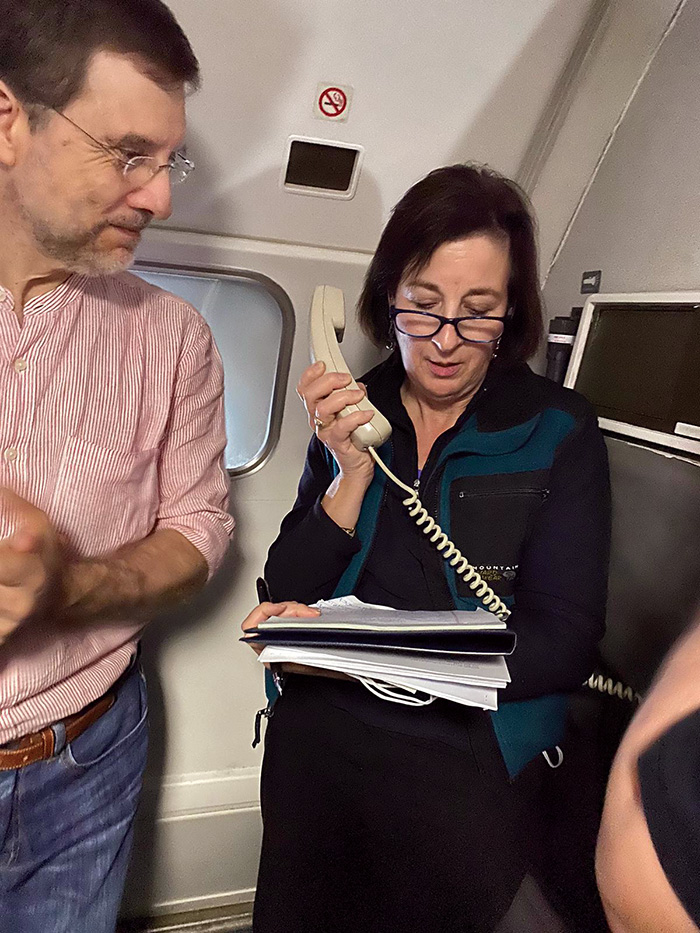Operation Nica Welcome
In February 2023, some 200 political prisoners were spirited to the United States from Nicaragua. Here’s the story of that unforgettable freedom flight.
BY KATE APPLEGATE

Diplomats and U.S. government personnel process a busload of political prisoners freed by the Ortega regime in the early morning of Feb. 9, 2023.
Mileydi Guilarte

Members from the Embassy Managua team and personnel from Washington set up to work on the tarmac at the Managua airport. In the foreground is a crate of Nicaraguan passports for the political prisoners that the government of Nicaragua turned over shortly before releasing them. In addition to matching passports to individuals, U.S. officials needed to verify that each prisoner was going to the U.S. voluntarily.
Mileydi Guilarte
The plane took off after midnight, mostly empty. Sitting in a largely vacant cabin, 10 U.S. Civil Service and Foreign Service officers chatted, listened to music, and tried to calm their nerves. One moved back to an empty seat to pray. Two days earlier, most had had no idea what was about to unfold. Lance Hegerle, then deputy director for Central American affairs at State, had reached out cryptically, inviting colleagues on a mission with the barest of details: Spanish speakers. Plane travel. Diplomatic passport. Twenty-four hours.
Just before takeoff from a naval base in Norfolk, Virginia, late on Feb. 8, 2023, the team learned their full mission. It sounded more Hollywood than HST. They would leave Norfolk Naval Station on a USAID-funded jet, land in Managua, pack the plane with some 200 political prisoners pulled hours earlier from their jail cells, and spirit them to the United States, all in a matter of hours.
The mission was unclassified, but lives were at stake. Loose lips could sink the trip, condemning the political prisoners to continued imprisonment under the regime of Daniel Ortega and his wife, Rosario Murillo. Many political prisoners had spent years behind bars. The plan to free them came about in a matter of days, after long months of backdoor diplomacy. It came to fruition on Jan. 29, when Nicaraguan Foreign Minister Denis Moncada posed an unexpected question to then-Ambassador Kevin Sullivan, who had led U.S. Embassy Managua since 2018. Would the United States accept all the political prisoners from Nicaragua?
A flurry of activity ensued. Ambassador Sullivan boarded a plane to Washington to rally the interagency response, entrusting Chargé d’Affaires Carla Fleharty and a tiny embassy team to secure regime agreement on logistics, timing, and assurance that only prisoners who freely consented would leave for the United States.
Negotiations with the regime were touch and go until the last minute, when the ambassador overcame a major disagreement that had threatened to derail the entire operation. With that phone call over, Operation Nica Welcome was a go.
While the plane winged its way from Norfolk to Nicaragua, an embassy team assembled in Managua. Chargé d’Affaires Fleharty, Acting Deputy Chief of Mission Ryan Reid, Information Officer Gaby Canavati, Acting Consular Chief Katie Jonas, Acting Regional Security Officer Will LaChance, and Defense Attaché Lt. Col. Dennis Rhoan climbed into a motor pool SUV, toting a large plastic crate stuffed with more than 220 freshly printed Nicaraguan passports. For prisoners with no prior passport, the regime had substituted mug shots.
About half the group had been arrested in 2018, when thousands of Nicaraguans protested proposed changes to social security. Security forces squelched dissent with live ammunition, injuring a few hundred people and arresting hundreds more. Over the coming months, security forces killed more than 300 protestors—some, newspapers showed, had been targeted by regime snipers.
The regime rounded up another wave of prisoners as the 2021 election loomed. Every presidential contender was arrested, seven candidates in all. Journalists, business figures, even Sandinistas who fought beside Ortega for decades, but later broke with him, were jailed. Many landed in the infamous “El Chipote” prison, in solitary confinement, without access to lawyers or loved ones.
The crackdown hit close to home for U.S. diplomats. As Managua’s political chief from 2020 to 2022, Hegerle remembers hosting Pedro Joaquín Chamorro, a journalist and politician, and his wife for wine and cheese one night in June 2021. The next day, Chamorro texted Hegerle just before his arrest. Then Chamorro’s WhatsApp line went silent.

The Nica Team (from left): Katrina Reichwein (from State Bureau of Western Hemisphere Affairs’ Monitoring Working Group), Katie Jonas (acting consul general in Managua), Ryan Reid (political-economic chief in Managua), Mileydi Guilarte (USAID deputy assistant administrator for Latin America and the Caribbean), Carla Fleharty (chargé d’affaires), Bill Muntean (from State Department Bureau of Oceans and International Environmental and Scientific Affairs), Marta Youth (former deputy chief of mission in Managua, now principal deputy assistant secretary in State’s Bureau of Population, Refugees, and Migration), Tanner Gildea (from State’s Office of Management Strategy and Solutions), Lance Hegerle (from State Bureau of Western Hemisphere Affairs’ Office of Central American Relations), and Gaby Canavati (Embassy Managua PAS).
Mileydi Guilarte
On Feb. 9, 2023, the embassy team met their Nicaraguan foreign ministry contacts at Managua’s airport after midnight. Reaching the tarmac on the military side of the facility, Reid spotted police clad in balaclavas, wielding automatic weapons. Out of the darkness came the roar of a dozen Russian-made buses. The windows were covered with blankets or paper, but the diplomats could see the passengers’ profiles: hands shackled, heads down. “That was the moment it was real,” Reid said.
The passengers clearly weren’t told where they were headed. Some concluded they were off to a judicial hearing or another prison. Seeing the plane, others figured they were headed to Cuba or Venezuela. Some were terrified they were about to be executed. “They seemed to have no clue what was happening,” Reid said. “They would step off the bus, and you could see them processing the plane, knowing that they’re leaving, but not knowing exactly what was going on.”
Fleharty greeted each person as they stepped off the bus, explaining the operation. Reid moved throughout the crowd, speaking with his contacts. Several prisoners realized what was happening upon glimpsing Hegerle and former Deputy Chief of Mission Marta Youth (now principal deputy assistant secretary for the Bureau of Population, Refugees, and Migration), former economics chief Bill Muntean (2015-2018), and other Embassy Managua veterans.
“Marta, I love you!” hollered Michael Healy, a U.S. citizen among the prisoners, kidding that this was his second U.S. government rescue. Healy was in good spirits. He approached Muntean, who had grown a long beard during the pandemic, and asked, “Bill, what the hell happened to you?”
“Mike, you’re the one who’s been in jail for the last year and a half!” Muntean replied.
Hegerle’s familiar face—if not his waistline—was another welcome sight for some. “Estamos más flacos,” former Nicaraguan Deputy Minister of Government and Foreign Affairs José Bernard Pallais gestured to his companions, giving Hegerle a mischievous smile. “Y tú—tú estás más gordo [We all got skinnier, but you—you’re fatter]!”
A former engineering student exited the bus and stopped. Reid watched him inhale deeply.
“I haven’t been outside in three years,” the student said. “Look at my skin. Look how pale I am.” Gazing at the sky, he took another deep breath of fresh air.
With no airline personnel, no airport employees, no paper or virtual tickets, the diplomats got to work. They flipped over the plastic crate that had held the passports and made a small table. Youth pulled out the small flashlight she always carries, a gift from her husband, to match passports to passengers. “I don’t think my husband ever envisioned that we’d be using the flashlight to read Nicaraguan passports in the dark,” Youth said.
Some Nicaraguans were visibly overwhelmed in choosing indefinite prison or an unknown future in the United States. One woman grieved, realizing she’d never see her dying mother again. A man whose family had visited him the day before in prison was anguished to leave them behind. Others wondered how they’d support themselves.

Marta Youth addresses passengers flight attendant–style. “We never forgot you,” she said. With her is Juan Lorenzo Holmann Chamorro, a Nicaraguan newspaper publisher who was jailed in 2021.
Mileydi Guilarte
The team was honest about the unknowns but assured them the U.S. government was committed to reuniting families. One man was tormented over whether to board the plane.
Hegerle offered basic facts: The Nicaraguans would receive U.S. humanitarian parole for two years and permission to work. He asked whether the man’s wife had brought homecooked meals to the jail, as many families do.
Yes, the man confirmed.
“If you work hard, you’ll be sending money back to your wife,” Hegerle pointed out. “If you get on this plane, you can be your family’s provider.”
The man walked up the jetway.
At another point, tensions on the tarmac rose between waiting passengers and military police. One prisoner paced back and forth near the plane, trying to decide whether to stay or go; police threatened to take him back. LaChance, Youth, and Hegerle stepped between him and the police, convinced him to board and hustled him into the cabin. Youth worried that if problems grew, the police might halt the entire operation, stranding the prisoners on the final buses.
After about two and a half hours, the buses were empty. As the sun began to rise, the plane’s crew ran through preflight checks and triple-checked the manifest. Finally, the Omni Air 767 taxied down the runway and lifted off.
The embassy team watched in silence. Canavati pulled out a cell phone to record the moment. “There it goes,” she said as she filmed the plane climbing into the brightening sky. “God bless America.”
Inside the cabin, the newly liberated Nicaraguans broke out in the national anthem. A chorus of chants rang out, extolling Nicaragua’s cities: “Viva, Nicaragua Libre!” “Viva, Managua!” “Viva, Masaya!” “Viva, Chinandega!”
Hegerle took to the plane’s intercom, previewing what would happen after landing. Passengers shared pens and began filling out the first of many forms they would see over the coming days.
Hegerle passed Youth the intercom. Reviewing some thoughts she’d scribbled on a piece of paper, Youth told the Nicaraguans that the United States had never forgotten them. It had kept fighting for the jailed dissidents: for better prison conditions, for rights to an attorney, for their freedom. “Finally, that day has come. I know that for you all, our departure from Nicaragua is bittersweet. But what’s important right now is that you are free. You are saved. You are safe. And you are with friends. We have to give thanks, because it’s almost a miracle.”
“We are here for you, and it’s an honor to accompany you,” she added. “It isn’t every day you get to travel with more than 200 heroes.”
Reunions began. Spouses, parents, and children, imprisoned separately, were suddenly face to face again. Three brothers compared their respective ordeals. Aisles filled with passengers hugging, shouting, making up for lost time. Stewards barely squeezed through with food service.
Upon landing at Dulles, the released political prisoners were celebrities. Ambassador Sullivan greeted them on the tarmac. A media helicopter hovered nearby for live coverage. Families, friends, and diaspora gathered beyond the sliding airport doors, clutching blue and white Nicaraguan flags.

Nicaraguans, freed hours earlier, take off from Managua, en route to the United States. The chartered flight carried 222 political prisoners released by the Ortega-Murillo regime to freedom—and many unknowns.
Mileydi Guilarte
Because the operation occurred outside the U.S. Refugee Admissions Program, the Nicaraguans didn’t qualify for refugee funding. Instead, they relied on volunteers and organizations that compressed lessons from 2021’s massive Afghan resettlement into mere days. More than 350 employees from State’s kaleidoscope of bureaus had volunteered just hours before to serve in an undisclosed crisis response. Some escorted the evacuees to a nearby hotel ballroom that became an ersatz Ellis Island. The Foreign Service Institute’s Spanish teachers interpreted so first responders could understand each freed prisoner’s personal needs.
Staffed with representatives from the Department of Homeland Security and the Department of Health and Human Services, Virginia and Fairfax County emergency responders, and various nongovernmental organizations, the ballroom was a 24-hour haven for acute medical response, meals, winter coats, cell phones, toiletries, onward travel, and ecstatic reunifications. After six days, all 222 passengers had departed, embarking on new lives in 25 states.
Much work remains. NGO partners are continuing case management. Teams in Embassy Managua and Embassy San José are helping the interagency reunite families amid intensified regime repression. Shortly after the prisoners were airborne, Ortega’s regime stripped citizenship from all 222, as well as 94 other Nicaraguans, seizing their property. The international community condemned it as a human rights violation and continues to call for Nicaragua’s return to democracy and the rule of law.
No one involved will ever forget the freedom flight. Secretary of State Antony Blinken praised the operation as a “model of what diplomacy can achieve for human rights and democracy in the most difficult circumstances.”
Then–Director for Central American Affairs Patrick Ventrell lauded the U.S. response. From the moment the regime made the offer to Ambassador Sullivan to release the prisoners, Ventrell said, there was no hesitation in how to respond. “Our only discussion was what size plane and how to land it,” he said.
Watching the freed Nicaraguans step from the Dulles escalators and out the sliding doors “was probably the most extraordinary moment in my entire career,” Ventrell said. “You design a policy, have a breakthrough, and—this is the moment why we do it all.”
When sharing or linking to FSJ articles online, which we welcome and encourage, please be sure to cite the magazine (The Foreign Service Journal) and the month and year of publication. Please check the permissions page for further details.
Read More...
- “Pitching In to do Vital Work” by Johnny Young, The Foreign Service Journal, April 2016
- “Diplomacy Works—First-Person Stories from the Field,” The Foreign Service Journal, December 2017
- “Nicaragua Frees Hundreds of Political Prisoners to the United States,” Maria Abi-Habib, The New York Times, February 2023









